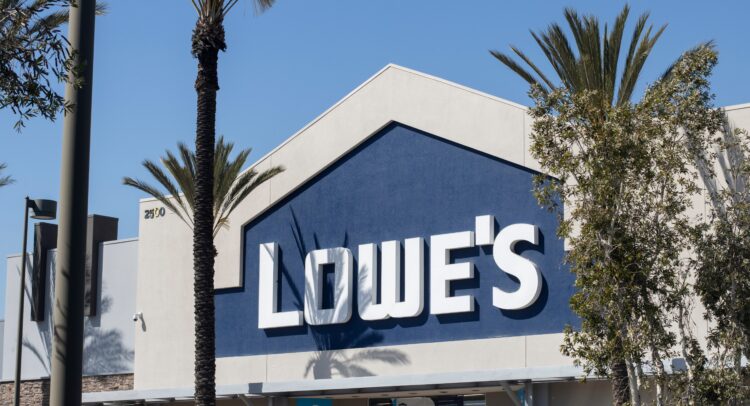Lowe’s (NYSE:LOW) is a U.S. home improvement retailer founded in 1946. The company is known for its stability, operating over 1,700 stores across North America. LOW stock is viewed as a stable, long-term choice in the consumer discretionary sector, given its revenue and cash flow consistency, dividend growth attributes, and share buybacks. Nonetheless, I am neutral on the stock due to its valuation.
Discover the Best Stocks and Maximize Your Portfolio:
- See what stocks are receiving strong buy ratings from top-rated analysts.
- Filter, analyze, and streamline your search for investment opportunities with TipRanks’ Stock Screener.
LOW Stock’s Recent Performance
Over the past year, LOW has seen its stock price decline by about 13%. Like many stocks in the consumer discretionary sector, as the broader market and the sector struggle, LOW has moved lower and is currently about 24% away from its all-time high.
However, on a longer-term basis, things look better. For the trailing five-year period, Lowe’s has delivered strong share price gains of 152%, beating both the S&P 500 (SPX), which returned about 55% during the same period, and the consumer discretionary sector by a wide margin.

Digesting Lowe’s Q4 Results
On March 1, 2023, the company released Q4-2022 and full-year results, more or less meeting analysts’ expectations. For the quarter, earnings per share (EPS) came in $0.07 (3%) higher than expected, while sales missed by $310 million. However, comparable sales decreasing by 1.5% year-over-year for the quarter, coupled with a more conservative FY-2023 revenue outlook ($88 billion – $90 billion vs. $90.5 billion initially expected) raised concerns, causing the stock to retreat.
Fiscal 2022 ended with sales of $97.1 billion, an adjusted operating margin of 13%, and adjusted earnings per share of $13.81, up 15% over the prior year. Even though full-year comparable sales decreased, the average ticket per consumer increased to $101.68.
For 2023 and 2024, analysts expect growth to slow down both in terms of sales and net profits. However, both metrics should stay above pre-pandemic levels, enabling the company to continue producing large amounts of cash flow to direct towards dividends and stock buybacks.
A Strong Buyback and Dividend Track Record
Speaking of buybacks, LOW has directed large amounts of free cash flows toward repurchasing its own stock. Since 2014, its share count has decreased from 1.05 billion to 601 million as of the most recent report. In total, for 2022, Lowe’s returned approximately $16.5 billion to shareholders through buybacks and dividend payments.
Now, speaking of dividends, Lowe’s is one of the stock market’s most famous dividend kings, having raised its payouts for 59 consecutive years. Even more recently, the company has continued to raise its dividend. Over the past 10 and five-year periods, payouts have increased at impressive compound annual growth rates (CAGRs) of +20%, beating sector and market average growth rates. LOW also consistently maintains a low payout ratio of under 40%.
The current yield of 2.1% is a bit higher than the market average and represents a $2.37 billion annual payment, while the company is generating free cash flow (cash from operations – CapEx) of over $6.7 billion. As such, the dividend should be considered safe, with a lot more room to grow in the future, provided that the company maintains solid financial performance.
And its financial performance has been solid. For instance, Lowe’s gross margin has increased from 31.8% in early 2020 to 33.2% currently, while its net margin stands above 6.6%. Despite maintaining slightly lower margins across the board compared to major competitor Home Depot (NYSE:HD), Lowe’s has maintained relatively strong profitability for a long time now.
Is LOW Stock Attractively Valued?
A stable, dividend-growth stock like Lowe’s is usually a buy-and-hold choice for the majority of investors. As such, it’s important to identify whether the current price is attractive enough to enable strong returns. Currently, LOW trades at a 14.4x P/E ratio while the sector median is 11.2x and the S&P 500 is around 21x. Given that growth is expected to stall over the next couple of years, it could be argued that the current multiple is a bit high.
On the other hand, the company’s strong cash flow generation and dividend history should compensate for investors paying a slight premium. On a price-to-sales (P/S) basis, LOW trades at 1.3x, a multiple that appears rather reasonable.
For further reference, Home Depot trades at a 17.2x P/E ratio and a 1.9x P/S ratio. While Lowe’s might appear cheap in comparison, HD also carries better top-line growth prospects over the medium term.
Is LOW Stock a Buy, According to Analysts?
Turning to Wall Street, Lowe’s has a Moderate Buy consensus rating based on 10 Buys, seven Holds, and one Sell rating assigned over the past three months. The average LOW stock price forecast of $229.13 represents 16.4% upside potential.

The Takeaway
Overall, Lowe’s remains a rather attractive choice for long-term investors who look for dividend growth and stable cash flow generation. Still, the company’s current valuation doesn’t imply a major bargain, leaving me neutral.









